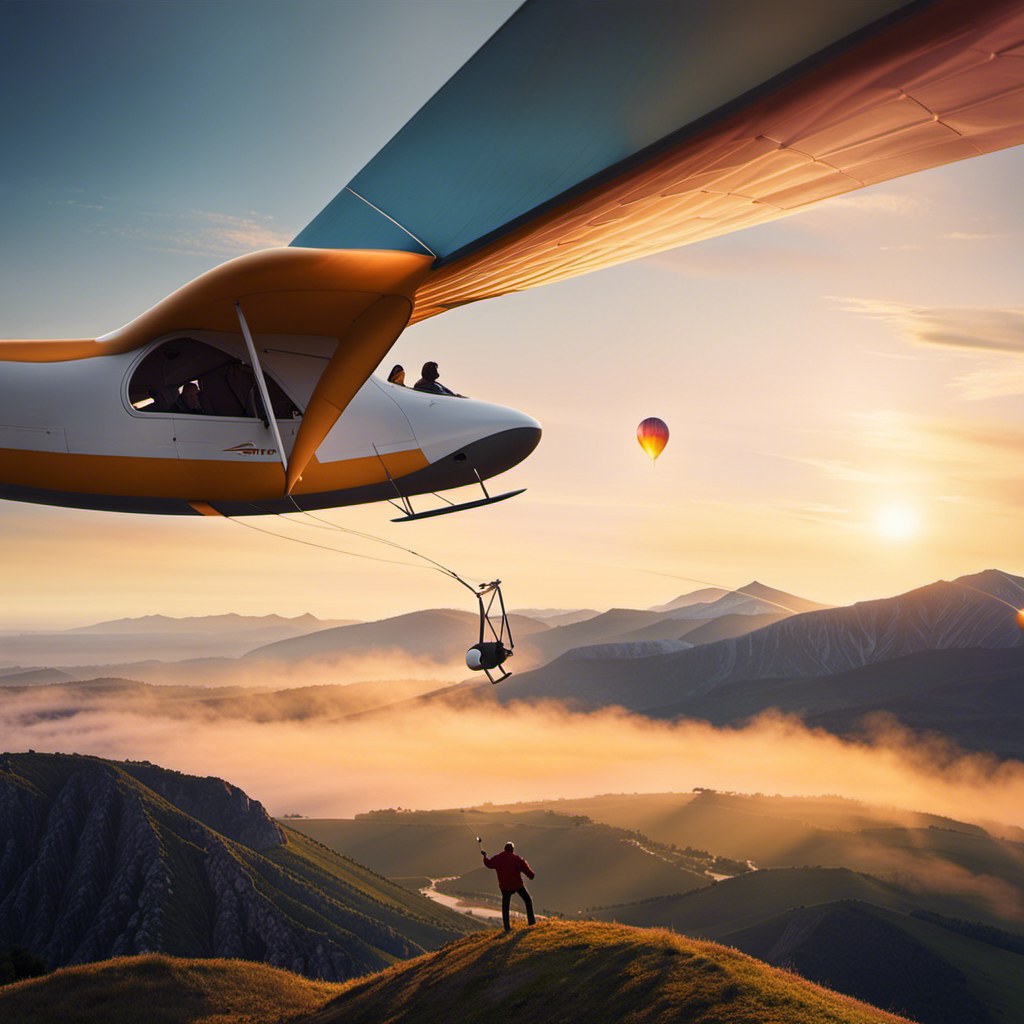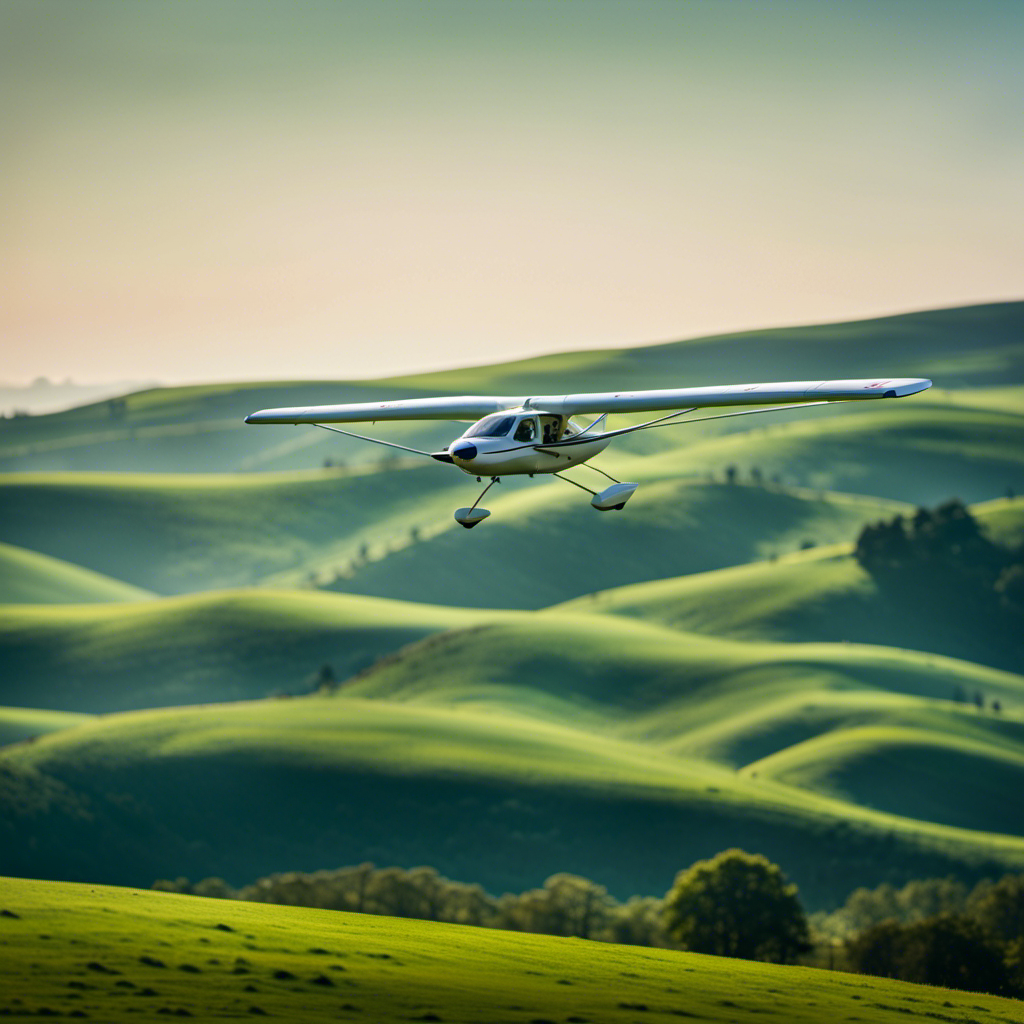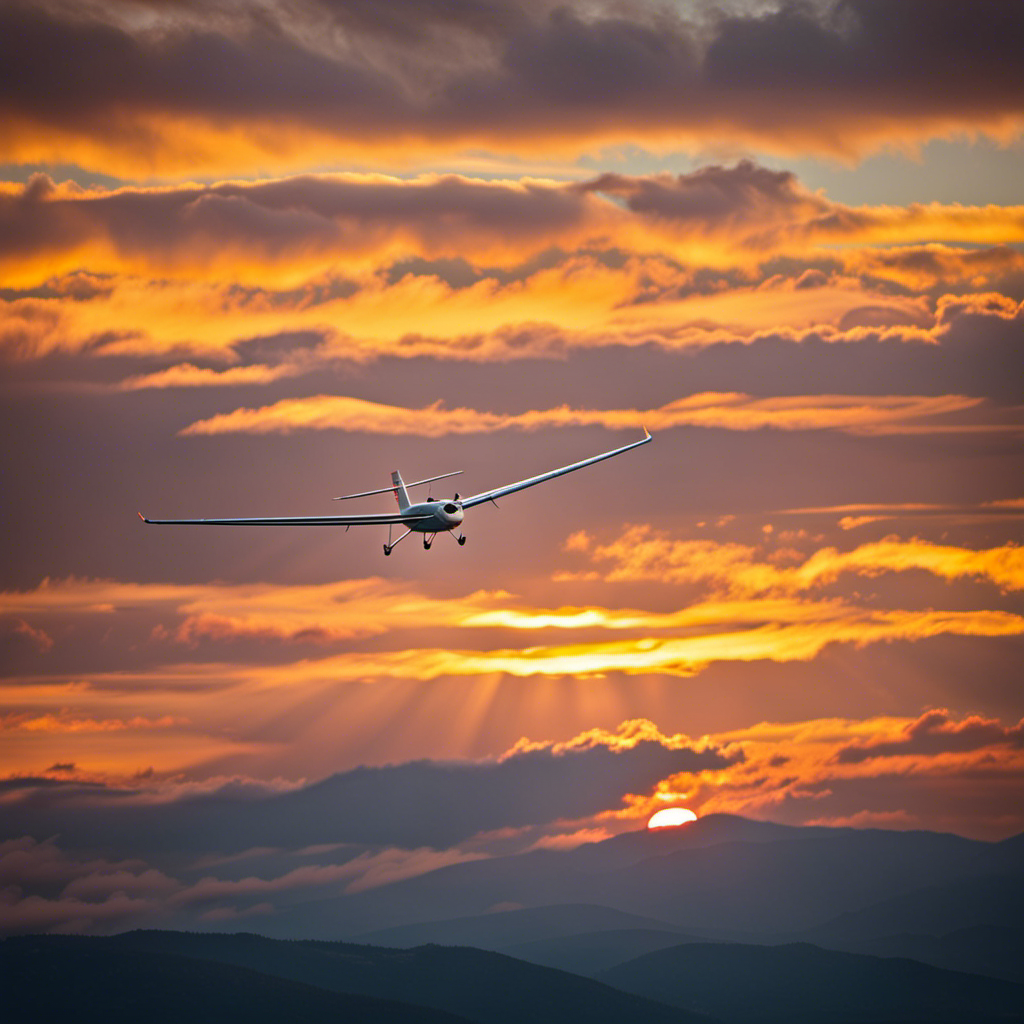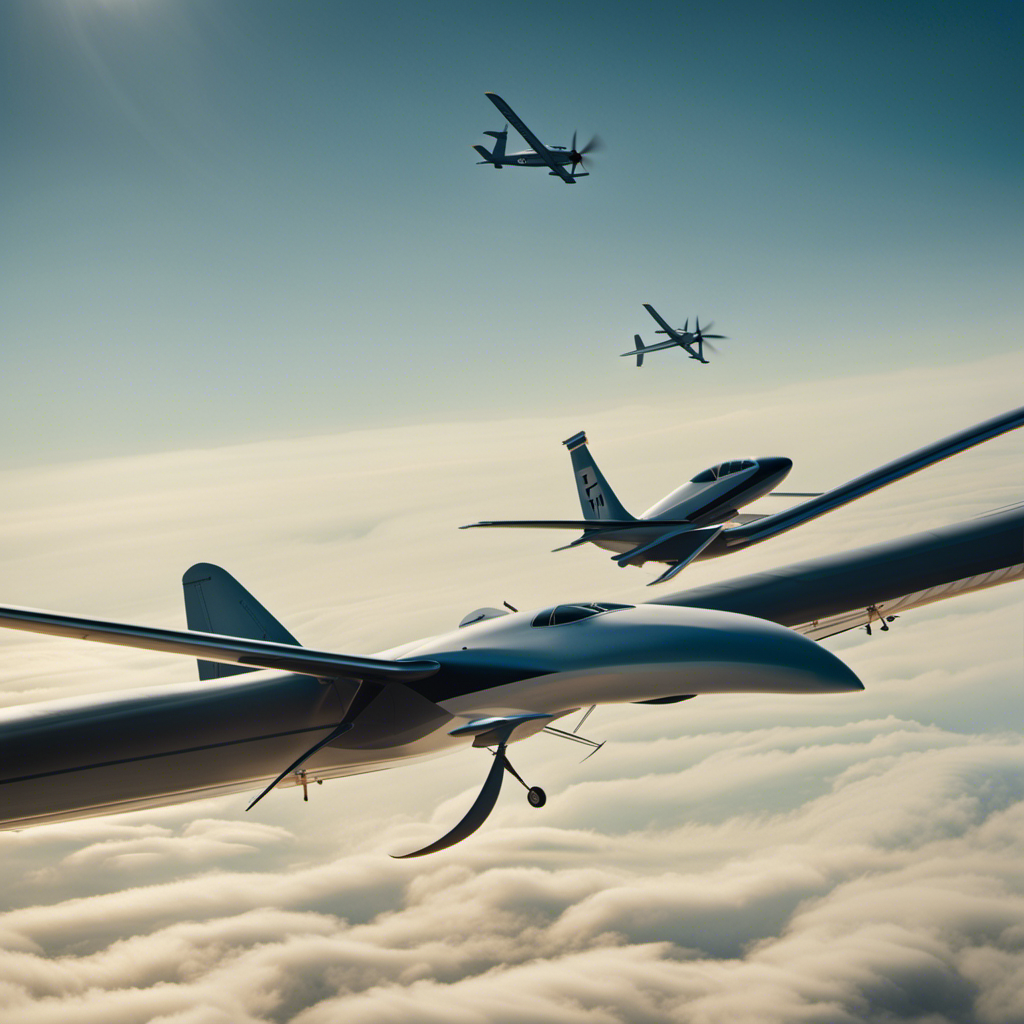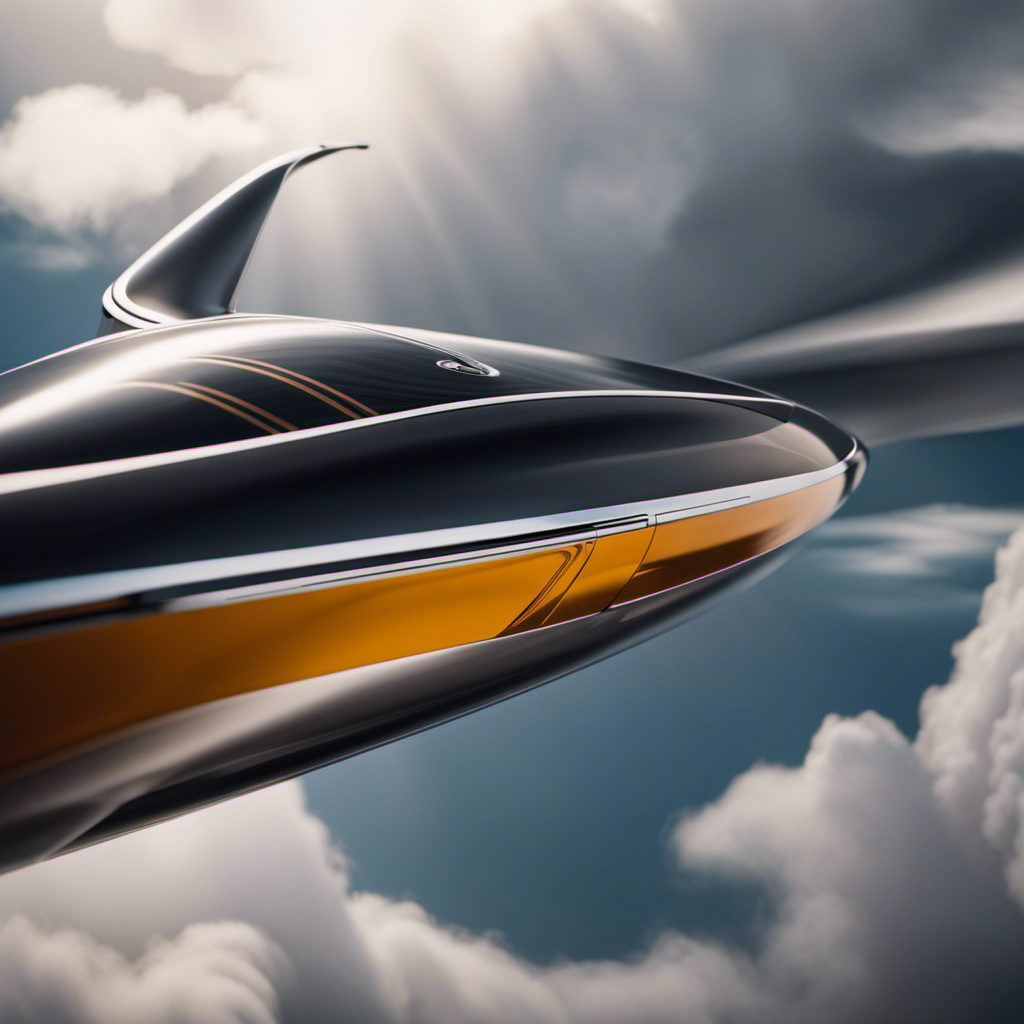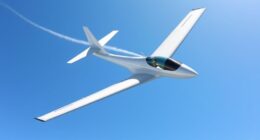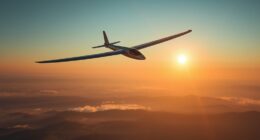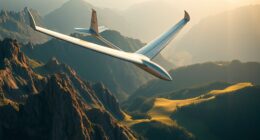In the realm of foot-launched gliders, I have found that the saying, “The sky is the limit!” holds true.
In this comprehensive guide, I’ll walk you through everything you need to know as a beginner in the exciting world of foot-launched gliding.
From understanding the equipment and safety procedures to mastering takeoff and landing, we’ll cover it all.
So buckle up, grab your wings, and get ready to soar to new heights!
Key Takeaways
- The equipment for foot launched gliding includes a harness, wing, helmet, and reserve parachute.
- Safety procedures involve pre-flight checks, wing inflation, and weather assessment.
- Proper body positioning is crucial for takeoff and landing.
- Understanding flight dynamics and practicing maneuvers improve pilot skills and control.
Understanding Foot Launched Gliders
Understanding foot launched gliders is essential for beginners to safely and effectively navigate the sport. Foot launched glider equipment plays a crucial role in ensuring a successful flight.
The equipment typically includes a harness, wing, helmet, and reserve parachute. The harness is designed to securely attach the pilot to the wing, providing stability and control during flight. The wing is the main component of the glider, consisting of a framework and fabric that generate lift.
Safety procedures are also an integral part of foot launched gliding. These procedures involve a thorough pre-flight check, proper wing inflation, and the use of safety gear, such as a helmet and reserve parachute.
Choosing the Right Equipment
To choose the right equipment, you’ll need to consider factors such as your skill level, budget, and the type of flying you want to do. When it comes to equipment selection for foot launched gliding, here are some key points to keep in mind:
-
Skill Level:
-
Beginner: Look for gliders that are stable and forgiving, with easy launching and landing characteristics.
-
Intermediate: Consider gliders with higher performance capabilities and more advanced features.
-
Advanced: Opt for gliders that offer the highest level of performance and maneuverability.
-
Budget Considerations:
-
Entry-level gliders tend to be more affordable.
-
Mid-range gliders offer a balance between cost and performance.
-
High-end gliders come with a higher price tag but offer top-tier performance.
-
Type of Flying:
-
Cross-country flights require gliders with good glide ratios and efficient thermaling abilities.
-
Acrobatic flying demands gliders that are agile and responsive.
Consider these factors carefully to ensure that you select the right equipment that aligns with your skill level, budget, and flying goals.
Understanding the importance of equipment selection is crucial before moving on to learning safety procedures.
Learning Safety Procedures
When it comes to foot launched gliding, safety should always be a top priority.
In this discussion, I will cover three key points: pre-flight safety checks, launching and landing techniques, and emergency protocols and safety tips.
Pre-flight safety checks
Before taking off, it’s important to perform pre-flight safety checks on your foot launched glider. These checks ensure that your equipment is in optimal condition and reduce the risk of accidents during flight. Here are some pre-flight safety tips to follow:
-
Inspect your pre-flight safety equipment:
- Check the integrity of your helmet, ensuring it fits properly and has no cracks or damage.
- Verify that your harness is secure and all straps are in good condition.
- Examine your reserve parachute, ensuring it is packed correctly and the deployment system is functioning properly.
-
Check the glider:
- Inspect the wing fabric for any tears, punctures, or signs of wear.
- Check the lines for any knots, frays, or tangles.
- Ensure that the risers, carabiners, and connectors are in good working condition.
-
Weather assessment:
- Check the current weather conditions and forecast to ensure they are suitable for flying.
- Assess wind direction and strength, as well as any potential turbulence or gusts.
- Consider factors such as visibility, cloud cover, and thermal activity.
Launching and landing techniques
Learning the proper launching and landing techniques is crucial for a successful flight. When it comes to safety precautions during takeoff and landing, there are a few key things to keep in mind.
First, always ensure that the wind conditions are suitable for launching. Check the wind direction and speed to avoid any unexpected turbulence.
Second, maintain a clear and unobstructed path during takeoff and landing to prevent any accidents or collisions.
As for common mistakes to avoid during launching and landing, be mindful of your approach angle and speed. Avoid coming in too fast or too steep, as this can lead to a hard landing or even a crash.
Lastly, always be prepared for unexpected situations and have emergency protocols and safety tips in place to handle any potential issues that may arise during your flight.
Transitioning into the subsequent section about emergency protocols and safety tips, it is important to have a thorough understanding of these procedures to ensure a safe and enjoyable experience.
Emergency protocols and safety tips
It’s important to always have emergency protocols and safety tips in place to handle any potential issues that may arise during your flight. When it comes to foot launched gliding, being prepared for emergencies is crucial.
Here are some key safety tips to keep in mind:
- Ensure proper communication equipment is available for emergency communication.
- Familiarize yourself with emergency landing techniques, such as landing in a designated area or avoiding obstacles.
- Stay calm and maintain situational awareness in case of an emergency.
- Practice emergency procedures regularly to build muscle memory and quick response.
- Always follow safety guidelines and regulations set by the authorities.
By having these protocols and safety tips in place, you can ensure a safer flying experience.
Now, let’s transition into the next section about mastering takeoff and landing techniques.
Mastering Takeoff and Landing
The key to mastering takeoff and landing in a foot launched glider is maintaining proper body positioning. By understanding the correct techniques, you can ensure a safe and efficient flight experience.
During takeoff, it is crucial to lean forward and maintain a running start until the glider lifts off the ground. Once airborne, the focus shifts to maintaining a balanced and stable position by adjusting the body as necessary.
When preparing for landing, it is essential to maintain a controlled descent and keep the body aligned with the glider’s direction. This helps absorb any impact upon touchdown and prevents injuries. Safety should always be the top priority when practicing these maneuvers.
Understanding flight dynamics, including lift, drag, and weight distribution, will further enhance your skills and enable you to navigate the skies with confidence.
Understanding Flight Dynamics
Understanding flight dynamics is crucial in order to navigate the skies with confidence and maximize the efficiency of your glider. Flight mechanics, which encompass the study of the forces and motions involved in flying, are essential to grasp.
By understanding the aerodynamic principles at play, you can make informed decisions and adjustments during your flight. Lift, drag, weight, and thrust are the key forces that affect your glider’s performance. Lift is generated by the shape of the wings, while drag opposes the direction of motion.
Weight is the force of gravity pulling the glider down, and thrust is the force propelling it forward. By mastering these principles, you can manipulate them to your advantage, allowing for smoother flights and improved maneuverability.
With a solid foundation in flight dynamics, you can now move on to practicing basic maneuvers, honing your skills as a foot launched glider pilot.
Practicing Basic Maneuvers
Once you’ve grasped flight dynamics, you can start practicing basic maneuvers to enhance your skills as a pilot. This is an exciting phase that allows you to explore the capabilities of your foot launched glider and improve your maneuver precision.
Here are some basic maneuver techniques to consider:
-
Wingovers: This maneuver involves smoothly banking the glider from side to side, creating a graceful arc in the sky. It can evoke a sense of exhilaration as you feel the G-forces pulling you through the turn.
-
Spirals: Spiraling downwards while maintaining control requires precise inputs and a keen understanding of the glider’s behavior. It can be both challenging and thrilling, giving you a rush of adrenaline.
Building Skills and Experience
Practicing these maneuvers will help you build the necessary skills and experience to become a more confident and proficient pilot.
When it comes to foot launched gliders, building techniques and gaining confidence are crucial to ensure a safe and enjoyable flight.
One of the key building techniques is perfecting the launch. This involves proper positioning of the glider, using the correct amount of force, and maintaining balance during takeoff.
Additionally, practicing controlled turns and maintaining steady altitude will enhance your flying skills.
As you continue to practice these maneuvers, you will gradually gain confidence in your abilities and become more comfortable with handling the glider.
Building skills and experience through repetitive practice is essential for your growth as a pilot.
Now that you have mastered these basic maneuvers, let’s explore different flying locations to further expand your horizons.
Exploring Different Flying Locations
To fully expand your horizons and explore different flying locations, you’ll want to research local flying clubs and connect with experienced pilots in your area. Here are three important steps to help you make the most of your flying adventures:
-
Research Scenic Locations: Look for areas known for their breathtaking landscapes and natural beauty. Coastal regions, mountain ranges, and national parks often offer stunning views from the air.
-
Master Flying Techniques: Each location may present unique challenges, such as strong winds, thermals, or narrow landing zones. Practice your flying techniques to ensure you can handle these situations confidently.
-
Learn Local Regulations: Different areas may have specific rules and regulations for flying. Familiarize yourself with these guidelines to ensure you fly safely and legally.
By exploring scenic locations, mastering flying techniques, and understanding local regulations, you can enhance your flying experience and take in the beauty of the world from above.
As you venture into the next section on safety and emergency preparedness, it’s important to be well-prepared for any unexpected situations that may arise.
Safety and Emergency Preparedness
When it comes to safety and emergency preparedness in flying, there are key points that should not be overlooked.
Dealing with unexpected weather conditions is crucial, as it can greatly affect the flight and pose potential dangers.
Emergency landing procedures should be understood and practiced, ensuring that pilots are prepared for any unforeseen circumstances.
Additionally, having knowledge of first aid and possessing essential safety equipment is vital for ensuring the well-being of both the pilot and passengers in case of emergencies.
Dealing with unexpected weather conditions
If you’re caught in unexpected weather conditions, it’s crucial to stay calm and assess the situation. As a foot launched glider pilot, dealing with turbulent winds and handling heavy rain requires specific techniques to ensure safety.
Here are some key points to keep in mind:
-
Monitor wind patterns: Stay aware of changing wind directions and speeds by observing nearby trees, flags, or other indicators. This will help you anticipate potential gusts or downdrafts.
-
Adjust your flight path: If you encounter turbulent winds, consider altering your course to avoid areas of strong turbulence. Look for smoother air by flying closer to the terrain or seeking sheltered areas.
-
Maintain control: Keep a firm grip on the control bar and make small, precise inputs to maintain stability in challenging conditions.
-
Rain protection: Ensure you have appropriate rain gear to protect yourself from heavy rain. Consider a waterproof flight suit and goggles to maintain visibility.
In the event of unexpected weather, it’s important to be prepared for emergency landing procedures. By staying vigilant and following these guidelines, you can navigate through challenging weather conditions with confidence.
Emergency landing procedures
In case of unexpected weather conditions, it’s crucial to know the emergency landing procedures. When faced with an imminent emergency landing, there are several techniques that can be employed to ensure a safe and controlled descent.
The first step is to assess the available landing options in the immediate vicinity. Look for open areas, fields, or clearings that can provide a suitable landing spot. It is important to maintain a steady glide path and avoid any obstacles during the descent.
Additionally, it’s essential to communicate the emergency situation to the appropriate authorities using the designated emergency communication procedures. This will help ensure that assistance is on its way and that any necessary emergency services are alerted.
Understanding and practicing these emergency landing techniques and communication procedures can greatly increase the chances of a successful outcome in unforeseen weather situations.
Now, let’s move on to discussing the first aid and safety equipment essentials.
First aid and safety equipment essentials
After covering emergency landing procedures, it is crucial to shift our focus to first aid and safety equipment essentials.
As a foot launched glider pilot, ensuring your safety and the safety of others is of utmost importance. First aid training equips you with the necessary knowledge and skills to respond effectively in case of injuries or emergencies. It is recommended to undergo a certified first aid training course to enhance your preparedness.
Additionally, having a safety equipment checklist is vital before every flight. This checklist should include items such as a helmet, harness, reserve parachute, and appropriate clothing. Regularly inspecting and maintaining your safety equipment is crucial to ensure its effectiveness.
By prioritizing first aid training and adhering to a safety equipment checklist, you can significantly mitigate risks and enjoy your foot launched gliding adventures safely.
Transitioning into joining the foot launched gliding community, let’s explore the various opportunities available for enthusiasts.
Joining the Foot Launched Gliding Community
When it comes to joining the foot launched gliding community, there are several key points to consider.
Firstly, connecting with other gliders and enthusiasts is crucial for sharing knowledge and experiences. This can be done through online forums, social media groups, and local flying clubs.
Secondly, participating in events and competitions not only allows for friendly competition, but also provides an opportunity to learn from more experienced gliders.
Connecting with other gliders and enthusiasts
To meet other gliders and enthusiasts, you can join online forums and social media groups dedicated to foot launched gliding. These platforms provide a valuable opportunity to connect with fellow gliders, share experiences, and learn from each other. By joining these communities, you can engage in discussions about various gliding techniques, equipment recommendations, and safety tips. It’s also a great way to stay updated with the latest news and developments in the world of foot launched gliding.
Furthermore, these online platforms often organize meetups and group flights, giving you the chance to connect with gliders in person and build lasting friendships. Connecting with other gliders not only enhances your knowledge and skills but also fosters a sense of camaraderie within the gliding community.
Transitioning into the subsequent section about participating in events and competitions, you’ll find that these online communities often share information about upcoming events and competitions. It’s a fantastic opportunity to put your skills to the test and challenge yourself against other experienced gliders.
Participating in events and competitions
After connecting with other gliders and enthusiasts, I was eager to take my foot launched glider skills to the next level by participating in events and competitions. Engaging in these activities not only allows me to showcase my abilities, but also exposes me to a wider community of experienced gliders who can offer valuable insights and guidance.
To excel in such events, I have developed various strategies and tactics that have proven to be effective. These include:
- Prioritizing practice sessions to improve my skills and enhance my performance.
- Studying the rules and regulations of each event to ensure compliance and avoid penalties.
- Analyzing the techniques of successful gliders and incorporating them into my own flying style.
Resources for continued learning and improvement
You can find various online forums and communities where experienced gliders share valuable resources and tips for continued learning and improvement. These platforms are an excellent source of information for those looking to explore advanced techniques and take their foot launched glider skills to the next level.
One of the key aspects of advancing in this sport is staying updated on the latest advancements in equipment. These online communities often discuss and review advanced equipment such as high-performance wings, lightweight harnesses, and state-of-the-art instruments. By participating in these forums and engaging with experienced gliders, you can gain insights into the best equipment options and how to effectively utilize them to enhance your flying experience.
Additionally, these communities provide a space for sharing experiences, discussing flight strategies, and seeking advice on specific challenges you may encounter during your gliding journey.
Frequently Asked Questions
Are there any age restrictions for foot launched gliding?
Age requirements for foot launched gliding vary depending on the country and organization. Safety precautions, such as physical fitness and training, are important regardless of age. It is recommended to consult local regulations and seek proper instruction before participating.
Is a license required to fly a foot launched glider?
No, a license is not required to fly a foot launched glider. However, it is important to follow safety guidelines to ensure a safe and enjoyable flight.
What are some common mistakes beginners make during takeoff and landing?
During takeoff and landing, beginners often make the common mistakes of rushing and having improper body positioning. Rushing can lead to accidents, while improper body positioning affects stability and control.
How long does it typically take to become proficient in foot launched gliding?
Becoming proficient in foot launched gliding requires a significant time commitment and a structured training process. The exact duration varies depending on the individual’s aptitude and dedication, but it typically takes several months to achieve proficiency.
Are there any weight restrictions for pilots of foot launched gliders?
Weight restrictions are an important safety consideration for pilots of foot launched gliders. According to safety regulations, the maximum weight for a pilot should not exceed 220 pounds, ensuring optimal performance and maneuverability of the glider.
Conclusion
In conclusion, embarking on the exhilarating journey of foot launched gliding requires dedication, practice, and a thirst for adventure. By understanding the mechanics of flight, selecting the appropriate gear, and prioritizing safety procedures, one can confidently take to the skies.
It is through mastering takeoff and landing techniques, comprehending flight dynamics, and building skills and experience that one truly becomes a gliding aficionado. Exploring different flying locations and being prepared for any safety or emergency situation further enriches this remarkable experience.
Join the foot launched gliding community and soar to new heights.
With a heart that soars as high as the skies, Aria, affectionately known as “Skylark,” is the driving force behind Soaring Skyways. Her journey into the gliding world began as a young dreamer gazing up at the soaring birds, yearning to experience the weightlessness and freedom they embodied. With years of experience both in the cockpit and behind the scenes, Aria’s commitment to the gliding community is unwavering.
